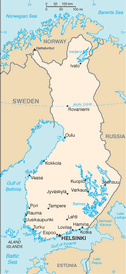Finland
 Finland is country of Europe located in north Europe.
Finland is country of Europe located in north Europe.
Details
| Official Name: | Republic of Finland |
| Capital: | Helsinki |
| Total area: | 338 424 km2 |
| GDP per capita: | $36,395 |
| Native Language: | Finnish, Swedish |
| Government: | Parliamentary republic |
| Population: | 5,421,827 |
| Major Religion: | Evangelical Lutheran Church of Finland |
| Monetary Unit: | Euro (EUR) |
Finland, a country of forests and lakes, is perhaps best known for its unspoilt natural beauty. In the far north, the White Nights, during which the sun does not set, last for around 10 weeks of the summer. In winter the same area goes through nearly eight weeks when the sun never rises above the horizon.
As a result of Finland being a part of Sweden for seven centuries (from the 12th century until 1809) some 6% of the population is Swedish-speaking. Finland became an independent state following the Russian revolution in 1917. Since this date Finland has been a republic. It has a one-chamber parliament whose 200 members are elected every four years.
The country has developed a modern, competitive economy, and is a world leader in telecommunications equipment. Main exports include telecoms equipment and engineering products, paper, pulp and lumber, glassware, stainless steel and ceramics.
Its remote northern beauty has inspired many artists, including the composer Jean Sibelius and the designer Alvar Aalto. Finland has also produced a number of top sports stars, including Formula One drivers Mika Häkkinen and Kimi Räikkönen.
Finnish cuisine has been influenced by continental, Russian and Swedish food. Traditional specialities include fish (especially salmon and turbot roe), as well as reindeer meat. Dishes to look out for include karjalanpiirakka (rice or potato pastry) and kalakukko (fish and pork fat baked inside a loaf).
Health & Welfare
The government provides comprehensive unemployment, sick leave, disability, old age insurance, family/child allowance, and war-invalid compensation.
Economy & Jobs
Forrest, metal, technology, and telecommunications.
Main Attractions
Helsinki, Olavinlinna Castle, Rauma city and Turku city (Finland's oldest).
Economy
Finland has a highly industrialized mixed economy with a per capita output equal to that of other European economies such as France, Germany, Belgium or the UK. The largest sector of the economy is services at 66%, followed by manufacturing and refining at 31%. Primary production is 2.9%. With respect to foreign trade, the key economic sector is manufacturing. The largest industries[67] are electronics (22%), machinery, vehicles and other engineered metal products (21.1%), forest industry (13%) and chemicals (11%).
Finland has timber and several mineral and freshwater resources. Forestry, paper factories, and the agricultural sector (on which taxpayers spend around 3 billion euros annually) are politically sensitive to rural residents. The Greater Helsinki area generates around a third of GDP. In a 2004 OECD comparison, high-technology manufacturing in Finland ranked second largest after Ireland. Knowledge-intensive services have also ranked the smallest and slow-growth sectors – especially agriculture and low-technology manufacturing – second largest after Ireland. Overall short-term outlook was good and GDP growth has been above many EU peers.
Immigration and residency
If you are interested in moving to the countries, either with a residence permit or by acquiring a citizenship, please contact us, and also get acquainted with the relevant migration documents.